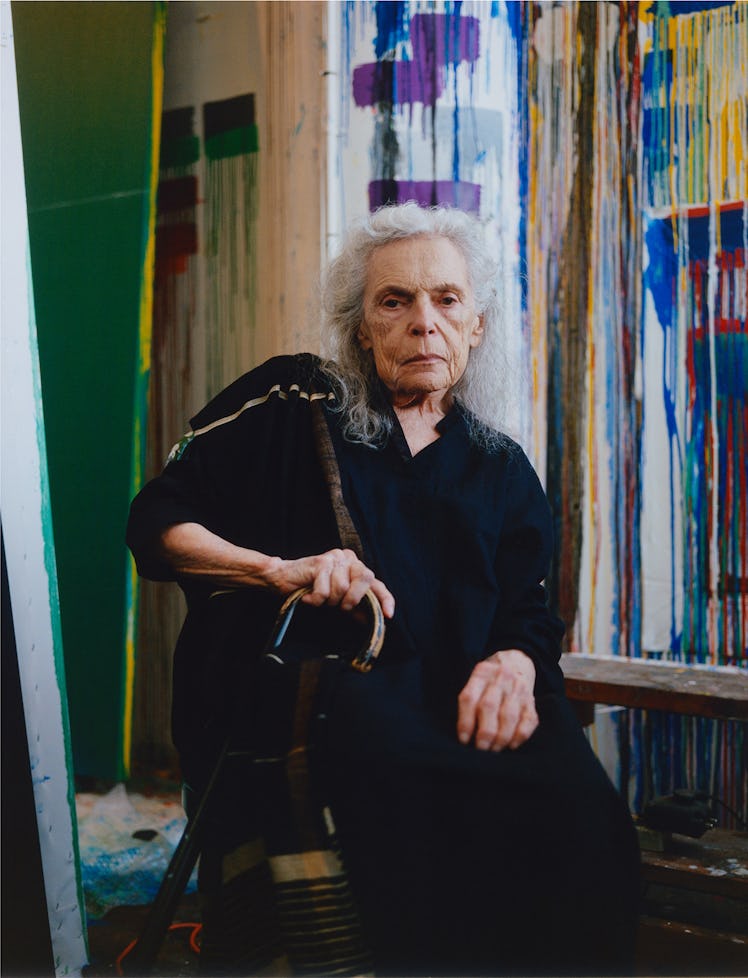Pat Steir Lets the Paint Decide
At 82, the pioneering abstract artist continues to push the limits of painting.

For W’s annual The Originals portfolio, we asked creatives—pioneers in the fields of art, design, fashion, comedy, activism, and more—to share their insights on staying true to themselves. See this year’s full class of creatives here.
Throughout your five-decade-plus career, your paintings have decked the halls of institutions like the Museum of Modern Art and the Whitney Museum of American Art, while defying the expectations those same academies have tried to instill. In the late 1980s, after you started your “Waterfall” series, a body of work that explores the ways that chance can make paint drip and splatter—a new group of which will be displayed at Hauser & Wirth later this year—you embraced abstraction. How do you relate to the figurative work of your early career versus everything that came after?
There’s no versus in my mind. If I look at a book with my early work, a book of the middle part, and a book from my late career, I see that every painting is a step toward the next. The contemporary work I’ve made for the past 30 years is about letting the paint make the work—relaxing, taking myself out of the picture.
Are you looking to disappear?
I take myself out of the painting. I take my will away; I let the will of the room and the paint and the wind and weather all make the painting. Of course, I draw some limits. I decide the size and what colors I’ll use. It’s not just chaos. But I’m not looking for something specific. I want to see something that I didn’t see before.
You have spoken about your admiration of poetry and were a cofounder and editor of the feminist journal Heresies. I’m curious about whether you keep a diary.
I don’t. I used to write about things I saw, things I thought. Since I have the telephone, I text-message them to people I know. It changed my practice. Sometimes I make notes for myself.
About your art?
No. I don’t think about art. I make notes about mixing color. But the notes are very unclear, because I try to get my student assistant to make notes, but the way he thinks to make the note is different than the way I think.
You’ve made some really large commissions in the past few years: a color wheel of 30 canvases for the Hirshhorn Museum and Sculpture Garden in Washington, D.C.; a suite of seven-feet-tall “Waterfall” paintings for the Barnes Foundation in Philadelphia; a palazzo-swallowing show at Gagosian in Rome. What is it like to take on those architecturally sized exhibitions?
The Hirshhorn was great fun to do. Marvelous fun. It’s an unusual space, and I’ve been thinking about color for years. I was working just in black and white, and then I started to think about color. And the color wheel seemed the perfect subject for the round space. It’s very intense, because we have three primary colors and three secondary ones that can be made into thousands of different colors.
What does the word “originality” mean to you?
Originality means not trying to be somebody else—to follow your own instincts and thoughts and desires. Because everyone is original, and no two are alike. Even identical twins are original. So, I don’t think one tries to get a good idea. A good idea is doing what you have to do.
In 2020, the filmmaker Veronica Gonzalez Peña released a documentary about you, Pat Steir: Artist, which was shot over the course of three years. What was that process like?
Veronica and her daughter became good friends of mine, so we had a lot of fun making the documentary. And it was very well received. I always think we should talk to everybody as though they were babies, to make everything clear. So that’s what I did in the documentary.
What’s the most unoriginal question you get asked about your work?
“Why are they so big?” That repeats again and again. And they’re so big because the size is a landscape size and not a window size. A painting hanging on the walls is like a window. But a huge painting 11 feet wide is like a doorway looking out into the landscape. Your eyes don’t see the edges of the painting. That question is asked all the time, and I answer it in the same way all the time. So, that must annoy people too.
Makeup by Linda Gradin for Westman Atelier at L’Atelier NYC.